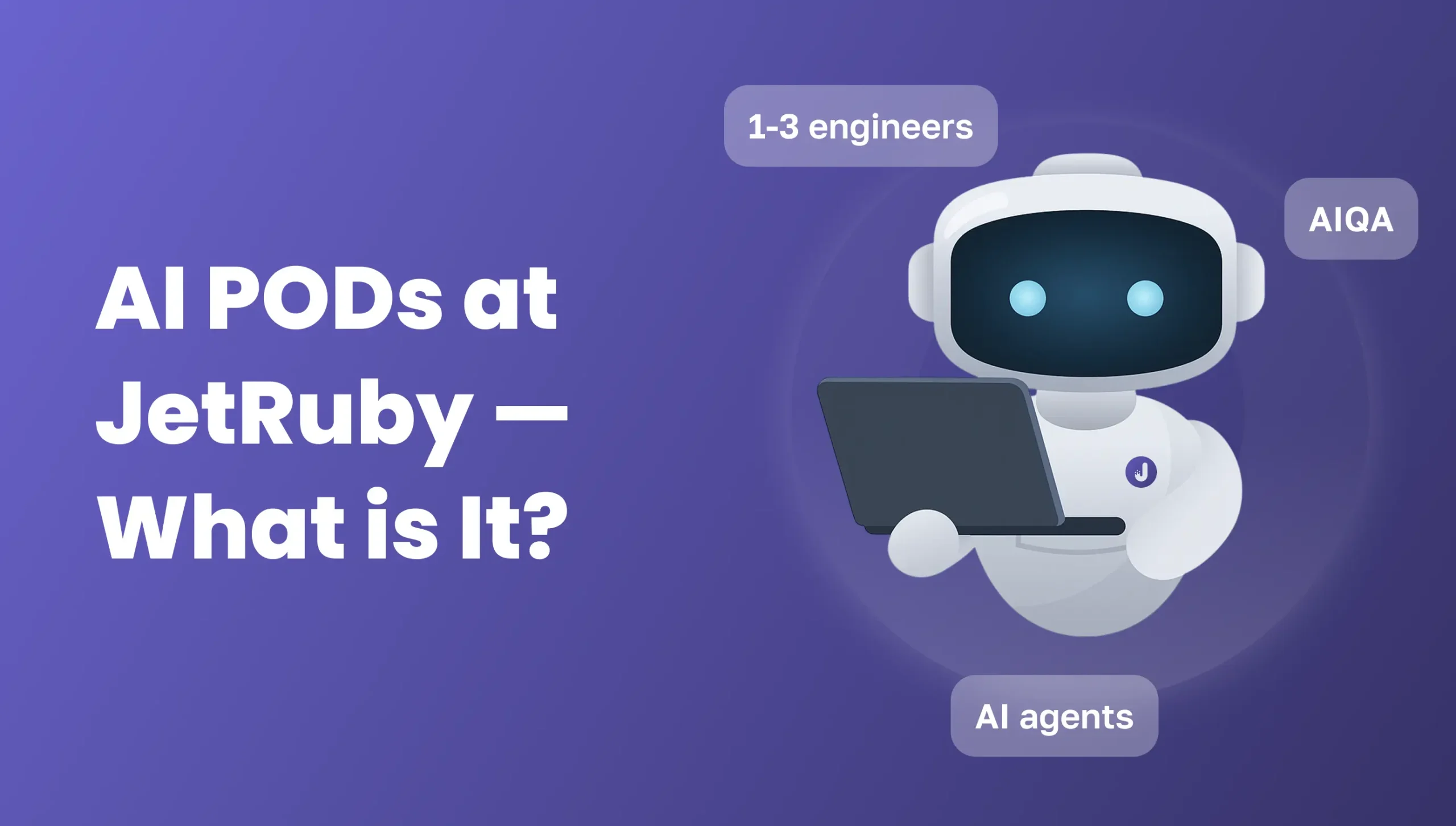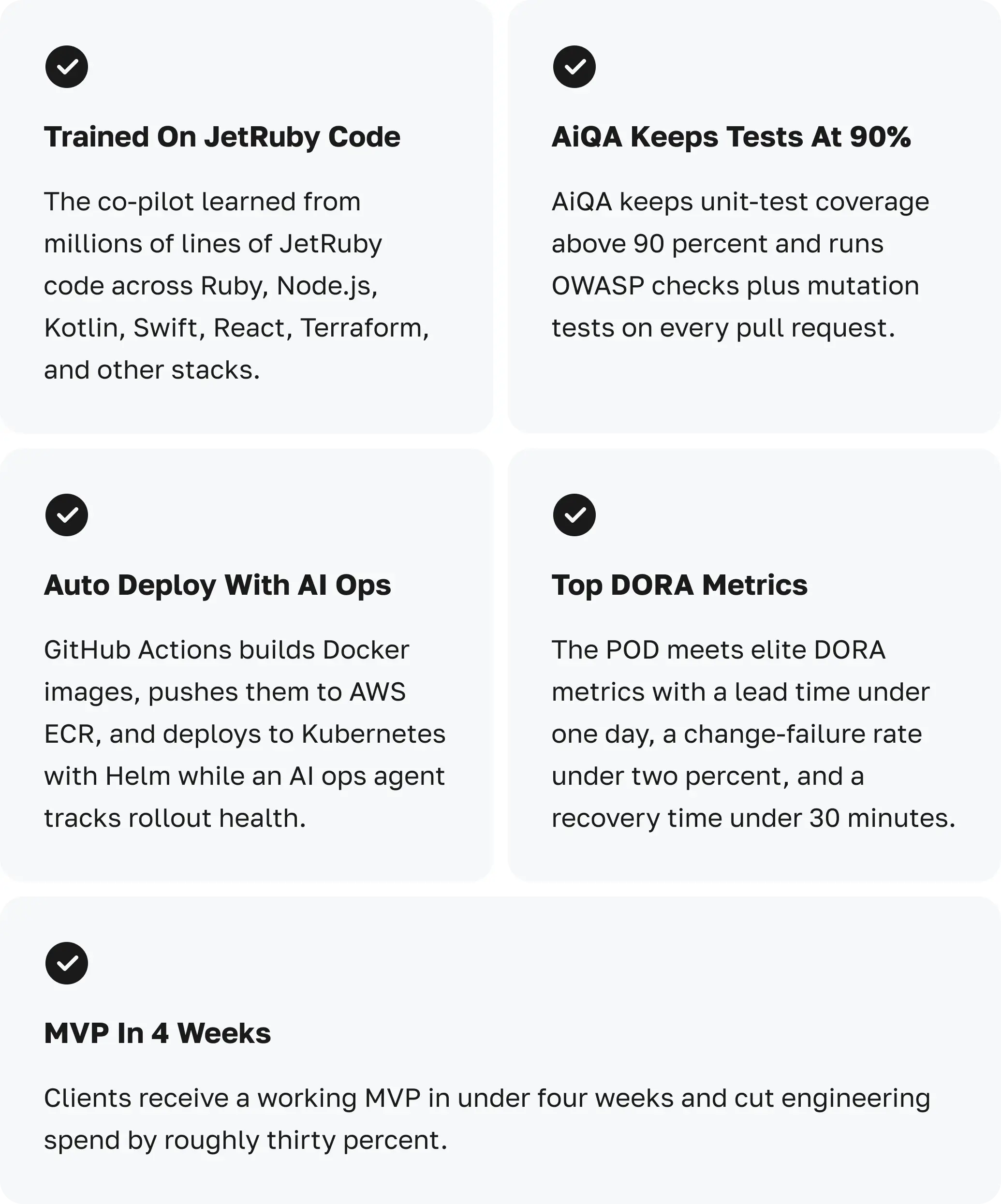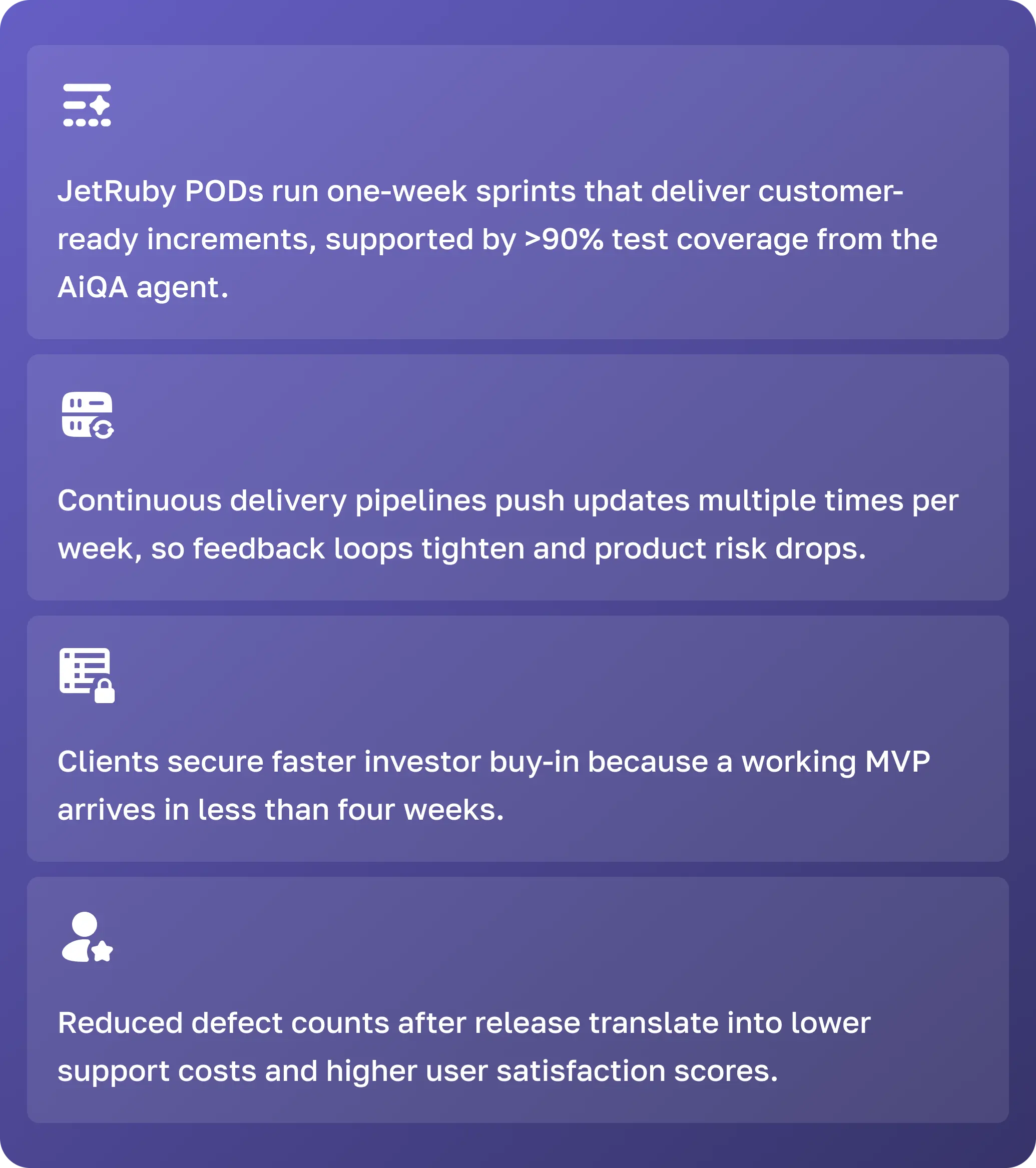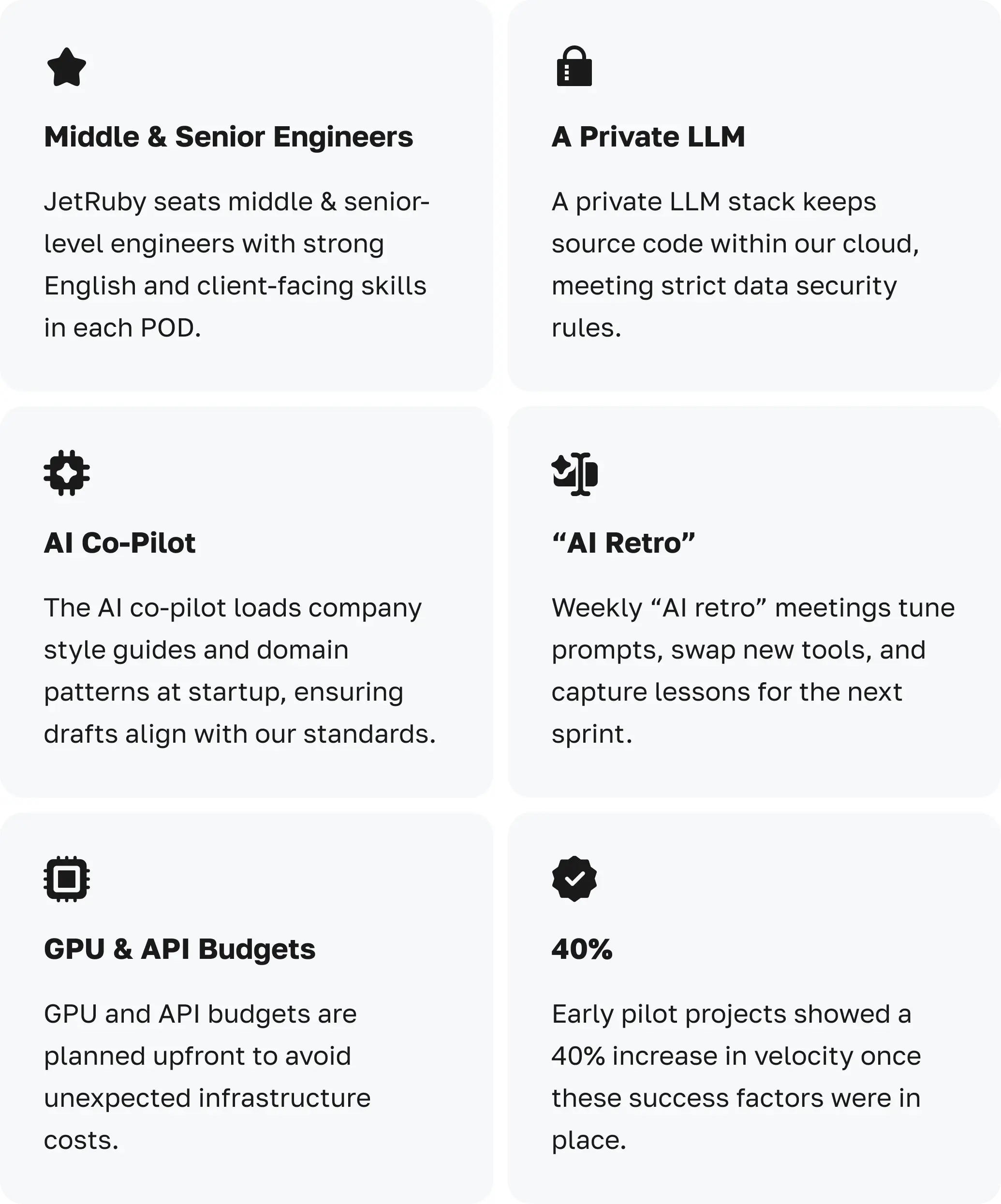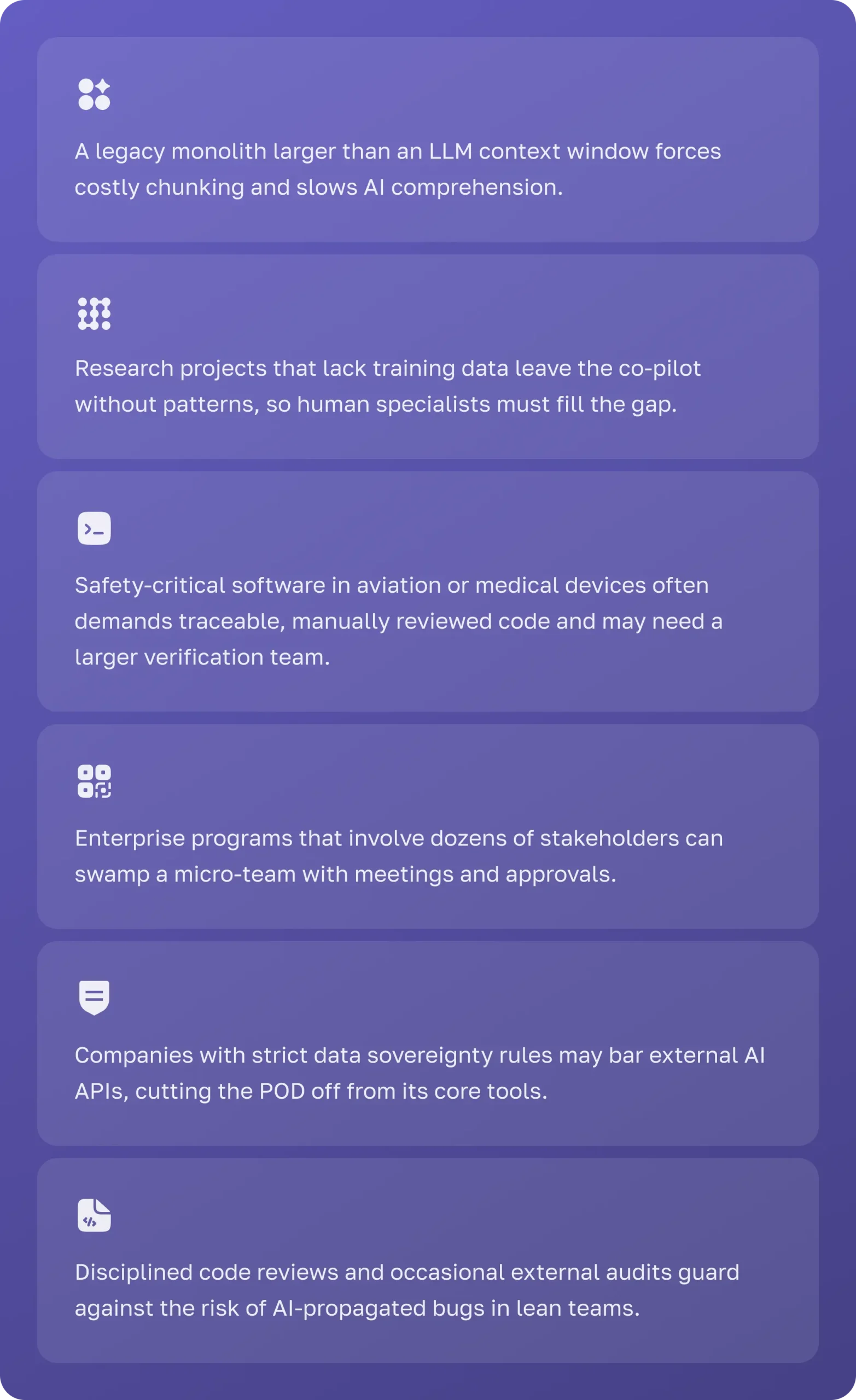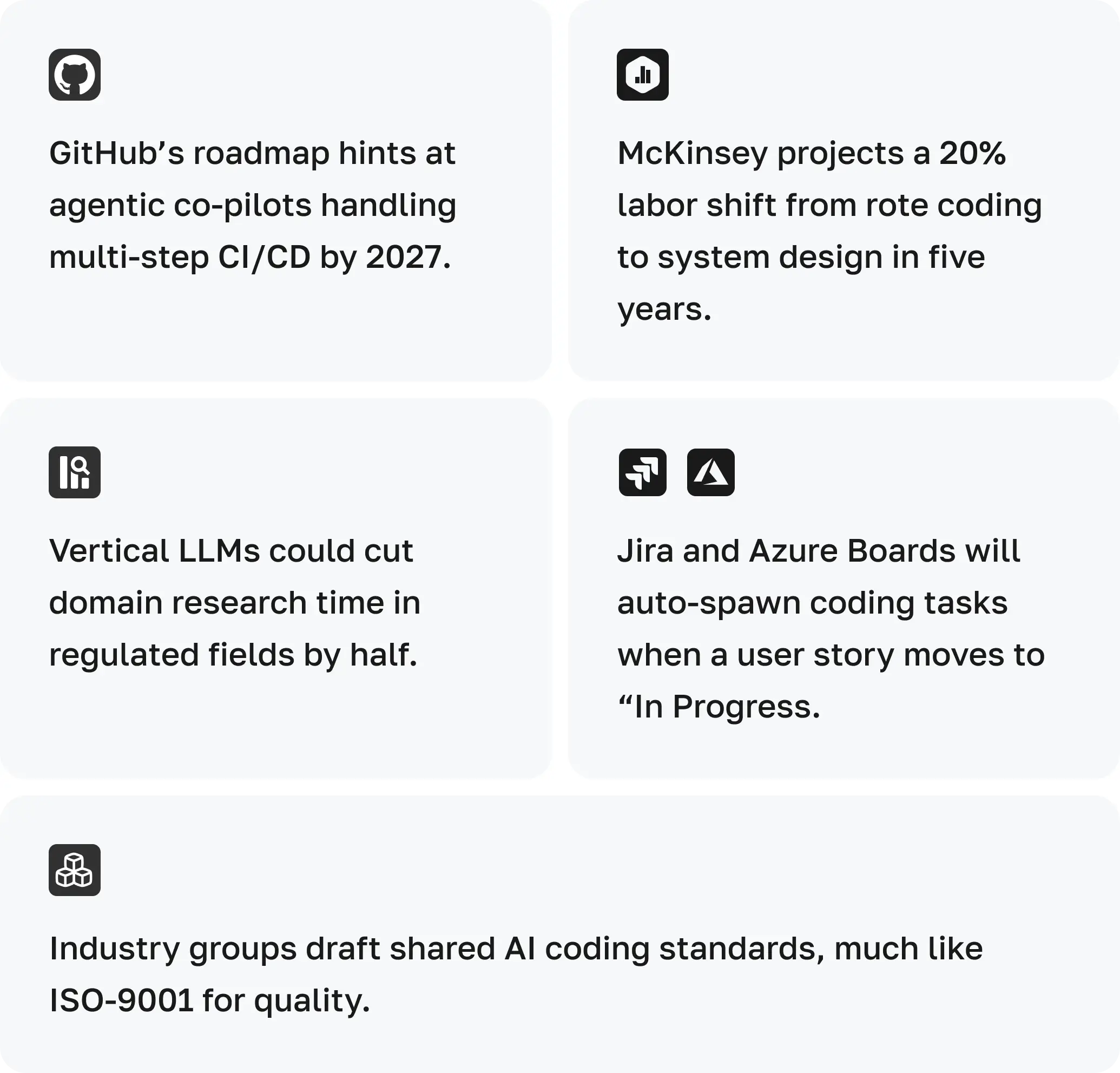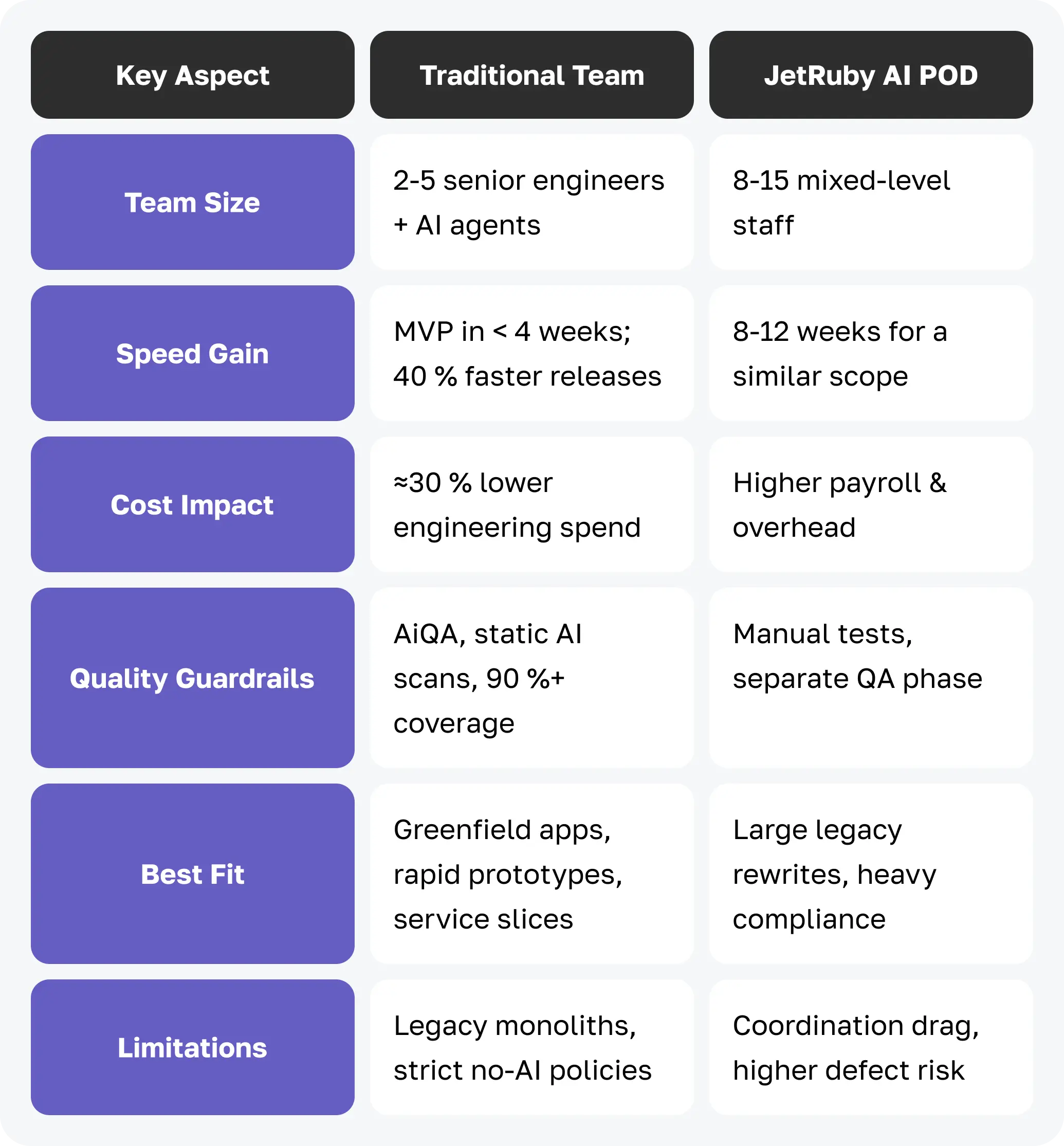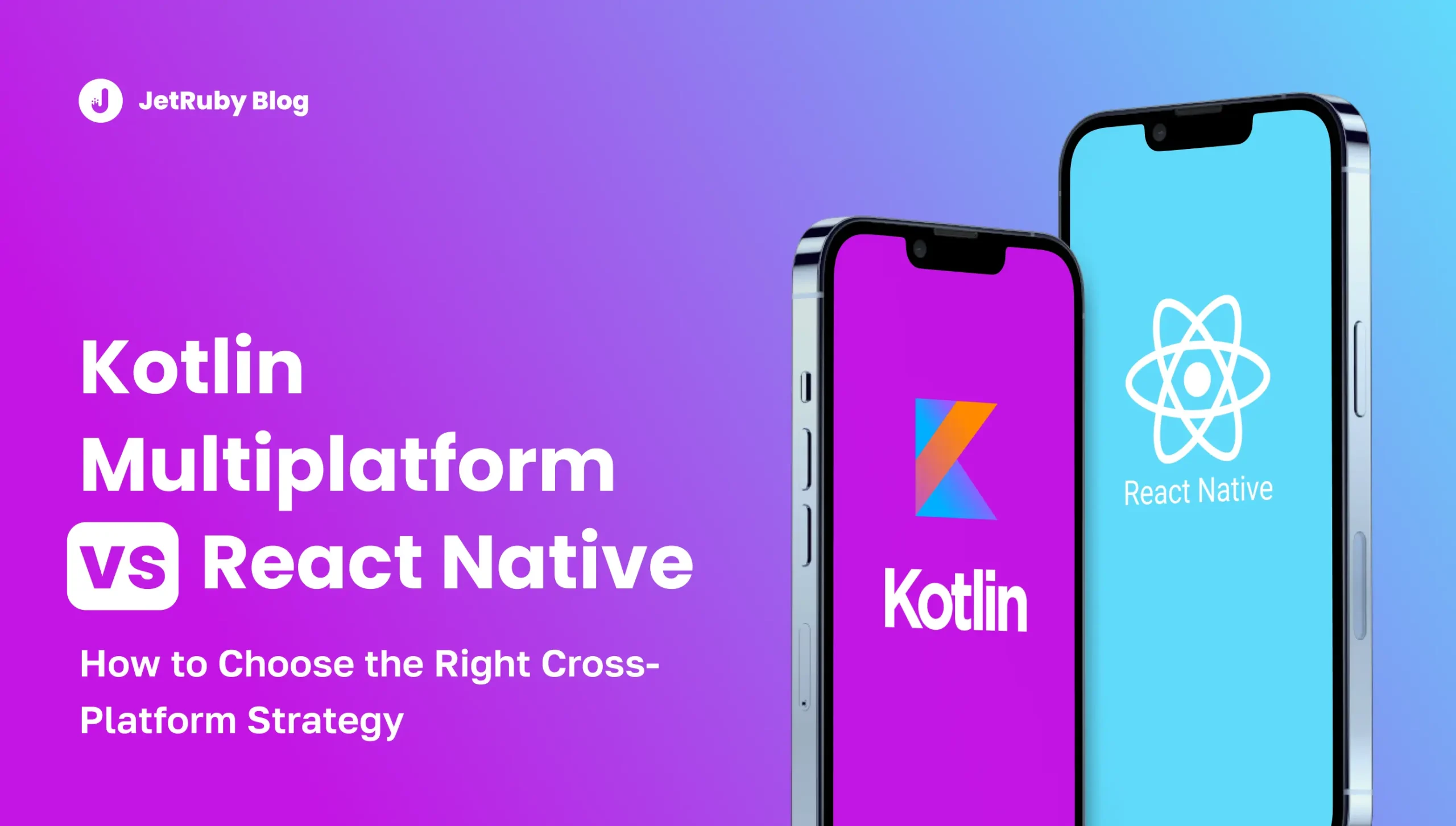Table of Contents
AI PODs represent a new approach to software development, where a small, highly skilled team works in tandem with AI tools to deliver projects faster and more efficiently.
The term “POD” is borrowed from Kubernetes (which uses “pods” to package software containers). Similarly, an AI POD is a self-contained unit of experts and AI components working together.
By embedding custom AI agents into our development process, we significantly accelerate timelines while maintaining high quality and keeping costs low.
This mirrors a broader industry trend: AI-augmented development can boost productivity by up to 40%, and JetRuby’s results prove it.
In this article, we’ll show how JetRuby’s AI POD teams are structured and run, the problems they solve that traditional teams can’t, and the tangible benefits they deliver.
What is an AI POD at JetRuby?
An AI POD at JetRuby is essentially a compact, high-performing squad (2–5 engineers + AIQA + AI agents) — a software development special forces team backed by AI assistants.
These AI assistants include code-generation tools, AI-driven testing utilities, and other “co-pilot” systems that we train based on our 15-year software development expertise and extensive codebase.
They help write code, catch bugs, generate tests, and handle routine tasks, all under the guidance of our engineers. More importantly, AI PODs don’t throw AI tools at a project. Instead, we reorganize the process to fully leverage those tools.
Rather than each developer spending all day writing code from scratch or manually testing, much of the heavy lifting is done by AI, with developers curating and guiding those AI outputs.
The concept arose as a response to the growing demand for leaner, more cost-effective development units.
Large developer groups can be expensive and unwieldy, so many clients now prefer having an “in-house” feel — a small team that can handle complex projects while delegating repetitive or mundane work to AI tools.
In other words, an AI POD strives to do more with less: fewer people but amplified productivity. Much like an elite commando unit compared to a conventional army platoon.
The big difference from a traditional team? In a normal setup, AI might be an add-on used sparingly or kept separate. In an AI POD, AI is embedded from day one as an active team member.
It’s deployed in planning, coding, and testing continuously, not as an afterthought. Our developers collaborate with the AI on each task, combining human creativity and judgment with machine speed and consistency.
JetRuby’s Journey to AI PODs
In 2023, as AI tools became vastly more capable, JetRuby began experimenting by pairing developers with AI assistants on projects. The outcome was striking: features built in record time, with fewer bugs.
Encouraged by this success, we formally adopted the AI POD model across the company by mid-2024.
A key part of this transition was training our AI agents on JetRuby’s entire 15-year codebase and project history. This provided the AI with a deep understanding of our coding standards, frameworks, and domain-specific patterns.
We reorganized our teams around small pods and trained our engineers to collaborate closely with the AI. Once the early PODs delivered outstanding results, it was clear this was the way forward.
Structure and Operation of JetRuby’s AI POD Teams
Unlike a traditional software project team that might include a dozen or more specialists (front-end developers, back-end developers, QA testers, UX designers, business analysts, etc.), an AI POD typically consists of just 2–5 people in total.
JetRuby designs each AI POD to be small but complete. Here’s a breakdown of the typical roles and components inside an AI POD:
- 1–3 Software Engineers: Full-stack developers or specialists who design and build features. Keeping the headcount low makes communication tight and decisions quick.
- AI QA Assistant (“AiQA”): An AI-driven quality assurance agent that continuously tests code and flags issues. It’s like having a tireless QA engineer on the team from day one.
- AI Coding Co-Pilot(s): AI tools integrated into the development environment. AI assistants write code, suggest improvements, and speed up routine programming tasks.
Engineers break the goal into atomic tasks, sketch data models, and outline API contracts. An AI design assistant then delivers architecture drafts, time estimates, and a risk matrix in seconds so the roadmap is clear before coding starts.
An AI co-pilot produces boilerplate, edge-case tests, and docstrings on demand. A developer reviews each snippet, patches nuances, and commits. At once, an AiQA bot launches various tests and security scans. Any issue loops back to the engineer within minutes.
This compact team has all the roles needed to deliver a project end-to-end. Because the pod includes its own QA and AI helpers, there’s no waiting on external departments.
As our G2 profile notes, these are “high-impact, compact teams… able to handle complex challenges with speed and surgical precision.”
Finally, AI PODs learn and improve with each project. We continually update our AI agents with the latest code and feedback from every project, so the next time they’re even smarter.
Every bug caught and feature built trains our AI to be even more effective, a compounding improvement traditional teams can’t match.
Our pods even use AI to automate project management tasks (like drafting documentation or status updates), freeing developers to focus on features.
Benefits of JetRuby AI PODs
JetRuby AI PODs deliver software with a pace and cost profile that large teams cannot match. A compact squad of two to five senior engineers works with AI co-pilots that generate boilerplate code, draft tests, and run security scans. This cuts idle time, meetings, and hand-offs.
Speed converts straight into business advantage. Our pods shave up to 40% off time-to-market, allowing clients to launch features months earlier and capture market share ahead of their rivals.
Smaller headcount plus AI automation also reduces labor hours, which lowers total engineering spending. Quality rises in parallel: continuous AI testing and security checks produce fewer defects, which saves future maintenance dollars and preserves brand reputation.
The model scales value, not payroll. One pod can handle work that once required an entire department, and multiple pods can run in parallel on separate product slices without coordination drag.
GitHub Copilot research shows that AI pair programming cuts individual coding time by 55%. And a small-team structure removes up to 39% of communication overhead compared to larger groups. This keeps budgets lean while letting ambitious roadmaps stay on track.
Because engineers spend more time on creative problem-solving and less on rote coding, morale remains high, and employee turnover stays low.
Besides, AI PODs directly address many common pain points in software development teams:
- Long timelines & large teams: Traditional projects can take months and require big teams (and budgets). AI PODs compress timelines by parallelizing work and automating tasks, so a small pod can deliver in the time a much larger team would need.
- Inconsistent quality: Human-only teams might miss bugs or skip best practices. In our pods, an AI QA runs continuous tests and code checks, catching issues early and enforcing high standards.
- Knowledge silos: On large projects, critical know-how is often tied to specific people. In an AI POD, the AI retains JetRuby’s 15-year knowledge base of code and solutions, so expertise isn’t lost, and onboarding new members is faster.
Challenges and Considerations
An AI POD only thrives when people, tools, and processes align. Each member must be a skilled engineer who treats AI as a partner, not a curiosity. They need clear coding standards, a secure AI toolchain, and lightweight rules for when humans override machine suggestions.
Trust remains front and center: the team owns every line of code the AI generates and is accountable for any defects. Finally, the POD must keep learning — new models appear monthly, so prompts and workflows evolve just as fast.
Potential Limitations and When an AI POD Is Not the Best Fit
AI PODs work best on fresh builds, MVPs, and clean service slices. They slow down when the codebase is huge, undocumented, or tangled with decades of business rules.
A legacy monolith may need months of discovery and refactoring that a three-person squad cannot cover. In that case, JetRuby adds a larger crew or runs a staged rewrite before the POD takes over new features.
Regulated products in aviation or healthcare demand traceable proofs and formal audits. Those steps erode the speed edge, so we pair the POD with compliance specialists and manual verifiers.
Culture also matters. If a client bans cloud AI services or distrusts machine-written code, the POD loses its edge and reverts to a normal small team.
Likewise, unclear strategy or shifting goals can derail any lean squad. AI accelerates execution, but it cannot resolve product direction chaos. Success still relies on human leadership, clear requirements, and an environment that fosters continuous AI learning.
Future of AI PODs
AI PODs stand where Agile did in 2001 — promising and still new. Analyst polls show three-quarters of developers already pair with generative AI, so the small-team model will spread fast.
JetRuby plans to double its POD capacity next year and license JetRuby.Flow to partners, positioning our format as a reference playbook.
Tooling will leap ahead. Co-pilots now suggest code. The next wave will open pull requests, run pipelines, and roll back bad builds without prompts. Domain LLMs, fine-tuned on medical or banking rules, will sit inside each POD as built-in consultants.
Org charts will shift. Titles like Prompt Engineer and AI Ops Lead will join Scrum boards. Velocity, burndown, and defect graphs will stream from AI dashboards in real time, so managers steer by outcomes, not guesswork.
Schools and bootcamps already pilot “AI-augmented developer” tracks to fill this skills gap.
Governance will mature in parallel. Clients will demand proof that AI outputs respect licenses, avoid bias, and log every change. JetRuby invests in traceable code stamps and bias-scan hooks, aiming to set the compliance bar before regulations lock in.
Conclusion: The JetRuby AI POD Advantage
Our small AI-powered teams are delivering in weeks which might take others months, and doing it with higher quality and lower cost. In short, it’s faster, better, cheaper, and seamlessly AI-integrated — that’s the JetRuby AI POD advantage.
Here’s a comparison table to see the real difference between an AI POD and a traditional team:
For decision-makers, the takeaway is clear: if speed, agility, and innovation are top priorities, it’s time to consider the AI POD approach.
We’ve embraced it fully at JetRuby. Now, we’re ready to help you achieve the same kind of breakthrough in your software development projects. Please contact us anytime you see fit.
